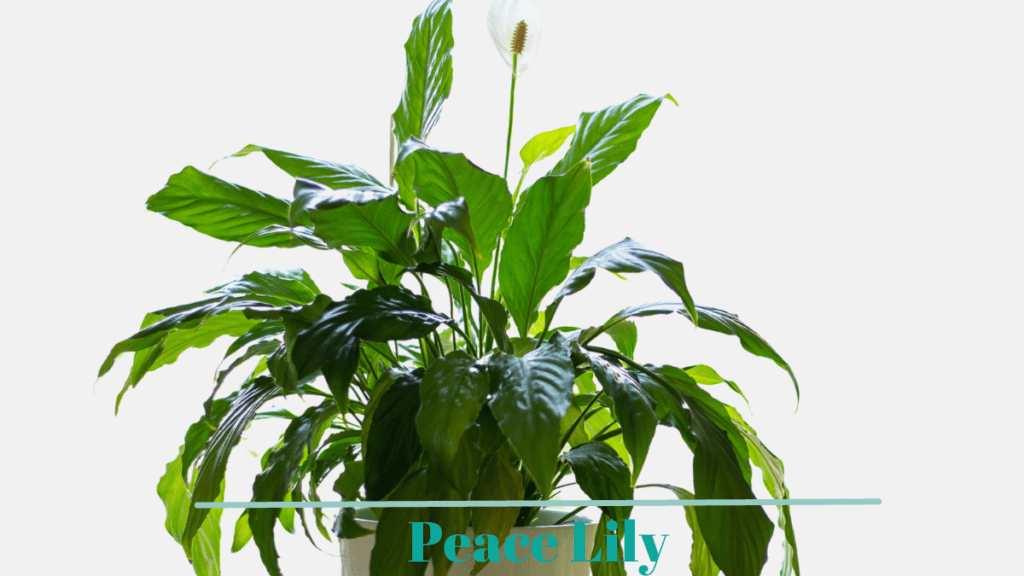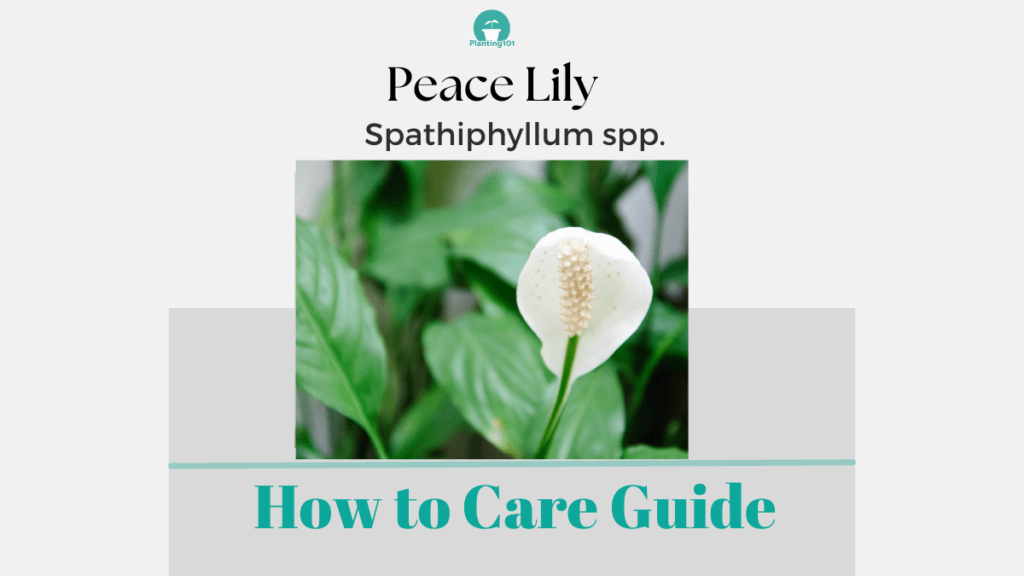Peace Lily (Spathiphyllum spp.) are easy-to-grow flowering houseplants. It is a great indoor plant for beginners because Peace Lilies can tolerate neglect.
Even if you forget to water your Peace Lily, you can easily revive it the next time you water it.
I love gifting Peace Lily plants to neighbors and friends because I know they will not have a hard time caring for them!

Peace lilies are also known to be beneficial air cleaners- absorbing harmful acetone, benzene, and formaldehyde from the air. Be aware that Peace Lily is toxic to pets and humans so keep it out of reach.
Here is a beginner’s guide on how to care for your Peace Lily at home.
Peace Lily Houseplant Care at a Glance
| Name | Peace Lily |
| Scientific Name | Spathiphyllum spp. |
| Care Level | Easy |
| Light | Medium Light. Can tolerate low light. |
| Daytime Temperature | 70 to 80 F (21-26C) |
| Night Time Temperature | 60 to 70 F (15-21C) |
| Water | Moderate Water |
| Humidity | High Humidity |
| Potting | Well-draining, organic, all-purpose potting mix |
| Fertilizer | Fertilize once a month at half strength. |
| Air Purifying Plant | Removes acetone, benzene, and formaldehyde |
| Toxic to Pets and Humans | Toxic |
Light
Peace Lily: Sun or Shade?
Peace Lily will grow best in bright filtered light. It can tolerate low light such as a north-facing window or a skylight. Avoid full sun.
Water
How Often Should You Water Your Peace Lily?
Your Peace Lily has moderate water requirements. Water your Peace Lily when the soil feels dry. The best way to tell when it is time to water your Peace Lily is to feel the soil.
Stick your finger in the soil 1 inch deep. If it feels dry, it’s time to water your Peace Lily.
Your Peace Lily can be adversely affected by chlorine in the water, so distilled water or rainwater is best for your Peace Lily.

How Do You Know When to Water Your Peace Lily?
Water your Peace Lily when the soil feels dry. The best way to tell when it’s time to water is by sticking your finger into the soil. Stick your finger in the soil 1 inch deep.
If the soil feels dry, then it’s time to water your Peace Lily.
What Type of Water Should You Use When Watering Your Peace Lily?
Your Peace Lily is best watered with distilled water or rainwater since it is sensitive to chlorine.
How Do You Make Sure There is Proper Drainage for Your Peace Lily?
Good drainage is important, you don’t want your Peace Lily to sit in soggy soil. Make sure there are drainage holes at the bottom of the pot.
After watering your Peace Lily and you see water draining out of the pot’s drainage holes, make sure you empty out the accumulated water in the saucer.
Don’t let your Peace Lily’s pot sit in this puddle of water. It will cause root rot!
Do You Need to Mist Your Peace Lily?
Your Peace Lily is a houseplant that likes humid conditions. You should increase indoor humidity. Mist your Peace Lily several times a week. Add humidity to indoor air with an air humidifier.
Soil
What Type of Potting Mix is Best for Your Peace Lily?
Your Peace Lily needs a well-draining, organic all-purpose potting mix.
How Do You Know When To Repot Your Peace Lily?
Repot your Peace Lily when it starts to outgrow its current pot. If you start seeing roots coming out of the drainage holes, that is an indication that your Peace Lily needs repotting.
When you repot your Peace Lily, move it to a container that is 4 inches in diameter larger than the current pot.
Fertilizer
Do You Need to Fertilize Your Peace Lily?
Your Peace Lily Fertilize your Peace Lily once a month at half strength during the growing season.
What Fertilizer Should You Use on Your Peace Lily?
Use a balanced organic fertilizer on your Peace Lily.
Propagation
How Do You Propagate Your Peace Lily?
Your Peace Lily is easy to propagate. You can propagate your Peace Lily plant by division of its rhizomes. Below are steps on how to propagate Peace Lily Plant by dividing its rhizomes.
1. Dig Up your Peace Lily Plant
Using a hand shovel, dig up your Peace Lily so you can lift out the entire plant. Be careful, don’t damage the roots and rhizomes. Dig a few inches away from the plant.
2. Divide the Peace Lily Rhizomes
Carefully divide up the rhizomes. Look for natural division points. Make sure each rhizome has its own stem, leaves and roots.
3. Plant the Peace Lily Rhizomes in a New Pot
Plant each Peace Lily rhizome into a new pot. Don’t plant the rhizomes too close together. Ideally, plant each one in its own pot. Water the new plant immediately after planting. Then water every 2-3 days until the roots are established.
4. Place New Peace Lily Plant in a Spot with Bright Indirect Sun
Place your new Peace Lily plant in a spot with bright indirect sunlight. Don’t put it in direct sunlight. Keep your Peace Lily plant in a spot that is warm and humid.
Common Problems of Peace Lily Care
The most common problems that affect Peace Lily are mealybugs, root rot and sunburn.
Peace Lily Problem: Fluffy White Growth In Between the Leaves and Stems
Problem: There are fluffy white growths in between the leaves and stems of your Peace Lily.
Cause: Mealybugs are causing the fluffy white growth on your Peace Lily. It is a common houseplant disease.
Solution: To get rid of mealybugs on your Peace Lily, wash your plant with water. You can also use soapy water. Spraying rubbing alcohol on affected areas can also get rid of mealybugs. Horticultural oil and insecticidal soap are also effective in getting rid of mealybugs.
Check out our article on how to make your own homemade pesticides using baby shampoo: How to Make Horticultural Oil and How to Make Insecticidal Soap
Peace Lily Problem: Brown and Black Patches on the Leaves of Your Peace Lily
Problem: There are brown and black patches on the leaves of your Peace Lily plant.
Cause: These brown or black patches on your Peace Lily are sunburn spots. Sunburn spots are caused by too much direct, hot sun on your Peace Lily.
Solution: Move your Peace Lily to a less sunny spot. The sunburn spots on your Peace Lily plant are permanent. The sunburn spots will not turn back to green.
Peace Lily Problem: Looks Wilted (Soil is Wet)
Problem: Your Peace Lily looks wilted even if the soil is wet. Check for root rot by pulling the plant out and examining the roots. If the roots of your Peace Lily plant look mushy (healthy roots are firm) and the roots are gray to black in color, these are telltale signs of root rot.
Cause: Root rot is caused by fungus and is a serious problem for your Peace Lily. Root rot is a result of wet soil due to overwatering or poor drainage.
Solution: When your Peace Lily is afflicted with root rot the chance of survival is slim. Your best course of action is to throw your Peace Lily out and start over with a new plant. This time don’t overwater your Peace Lily and make sure there is good drainage in the pot.
Peace Lily: Air Purifying Plant
Peace Lily is an air purifying plant. It will clean the air by removing air pollutants such as acetone, benzene, and formaldehyde.
In a NASA research study, Peace Lily is effective in removing trichloroethylene (TCE), benzene, and formaldehyde. In fact, the NASA study showed that Peace Lily effectively removed 79.5% of benzene in the air and 23% of trichloroethylene in the air.
Cleaning Peace Lily Houseplant
What’s the best way to clean the leaves of your Peace Lily?
Dust accumulates on your Peace Lily leaves over time. The layer of dust decreases the plant’s ability to photosynthesize. Periodically wiping down the leaves of your Peace Lily with a damp cloth will help keep your plant healthy.
You can also use a duster or dry duster cloth to wipe off the layer of dust on the leaves. Avoid using leaf-shining chemicals on your Peace Lily, it will clog up the leaf pores.
Peace Lily: Size
Depending on the Peace Lily cultivar, some can grow to 2 to 3 feet tall and wide while the miniature varieties are under 1 foot tall and wide.
Peace Lily: Toxic to Pets?
Peace Lilys are toxic to humans and pets. Don’t let children or pets chew on the leaves of the Peace Lily plant because it contains calcium oxalate crystals. The crystals can cause vomiting and difficulty breathing.
It can also result in swelling of lips, tongue, and mouth and excessive drooling. If you see any of these symptoms and suspect ingestion of Peace Lily plants, call poison control immediately!
Also, call your doctor or vet once you start seeing adverse reactions in children and pets.
Get Your FREE Weekly Plant Care Tracker Printable

Sign up once and you will get access to ALL exclusive content on this website. After unlocking the printable, just save the printable image and then print it. Keep it in a binder and use it to keep track of your weekly plant care! I hope you like it!
You May Also Be Interested In:
How to Take Care of Haworthia (infograph)


